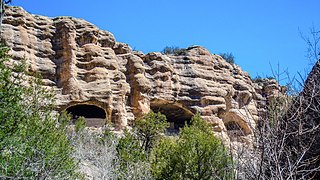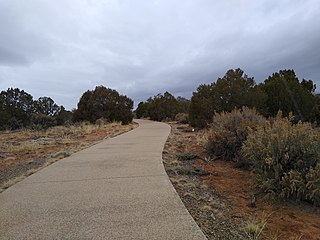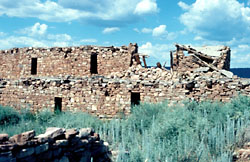Geography

The Bailey Ruins are located mainly in a ponderosa forest in the Apache-Sitgreaves National Forests and partly on a private ranch, about 1.6 miles (2.6 km) from the Mogollon Rim at 6,808 feet (2,075 m) in elevation. [3]
Bailey Ruin | |
| Nearest city | Pinedale |
|---|---|
| Area | 12.4 acres (5.0 ha) |
| Architectural style | Pueblo |
| NRHP reference No. | 05001560 [1] |
| Added to NRHP | March 17, 2006 [1] |
Bailey Ruin is an archaeological site located in Navajo County, Arizona, United States. The site, also known as "Stott Ranch Ruin" and "Pope Ranch Site," was added to the National Register of Historic Places on March 17, 2006 for its historical and archaeological significance. [2]
Bailey Ruin, a well-preserved Ancient Puebloan site, was occupied from about AD 1275 to 1325, in the late Pueblo III Era to early Pueblo IV Era. [3]

The Bailey Ruins are located mainly in a ponderosa forest in the Apache-Sitgreaves National Forests and partly on a private ranch, about 1.6 miles (2.6 km) from the Mogollon Rim at 6,808 feet (2,075 m) in elevation. [3]
The site was a multi-storied complex of 200 to 250 rooms that appeared to grow gradually in size from AD 1275 to 1325. Around the turn of the 14th century, the plaza was enclosed by the addition of clusters of rooms. The site had several water sources: a cienega about 660 feet (200 m) from the pueblo and nearby springs. Currently there are shallow historic wells. [3]
Archaeological interest in the site began before the turn of the 20th century.

Catron County is a county in the U.S. state of New Mexico. As of the 2020 census, the population was 3,579, making it New Mexico's third-least populous county. Its county seat is Reserve. Catron County is New Mexico's largest county by area.

The Wupatki National Monument is a United States National Monument located in north-central Arizona, near Flagstaff. Rich in Native American archaeological sites, the monument is administered by the National Park Service in close conjunction with the nearby Sunset Crater Volcano National Monument. Wupatki was established as a national monument in 1924 and was listed on the National Register of Historic Places on October 15, 1966. The listing included three contributing buildings and 29 contributing structures on 35,422 acres (14,335 ha).

The Apache–Sitgreaves National Forests is a 2.76-million-acre (11,169 km2) United States National Forest which runs along the Mogollon Rim and the White Mountains in east-central Arizona and into the U.S. state of New Mexico. Formerly two forests, it is currently managed as one unit by USDA Forest Service from the Forest Supervisors Office in Springerville, Arizona. Apache–Sitgreaves has over 400 species of wildlife. With its high elevation and cool summer breezes it is a popular weekend destination from the hot desert for Phoenix, Arizona, residents. The forest is divided into 5 Ranger Districts that span almost 300 miles (480 km) from Clifton, Arizona in the east-central portion of Arizona to the eastern boundary of the Coconino National Forest in north-central Arizona. The Apache–Sitgreaves National Forest borders the western and northern borders of the Fort Apache Indian Reservation. It is located in parts of Greenlee, Apache, Navajo, and Coconino counties in eastern and east-central Arizona, and Catron County in western New Mexico. The more northwesterly Sitgreaves National Forest portion lies adjacent to the north side of the Fort Apache Indian Reservation and is located entirely in Arizona, within Navajo, Apache, and Coconino counties. It has a total area of 818,651 acres (3,313 km2). The more southeasterly and much larger Apache National Forest portion lies adjacent to the east side of the Fort Apache and the San Carlos Indian Reservations. It lies on both sides of the border with New Mexico, in Greenlee, Catron, and Apache counties. It has a total area of 1,813,601 acres (7,339 km2).

Gila Cliff Dwellings National Monument is a U.S. National Monument created to protect Mogollon cliff dwellings in the Gila Wilderness on the headwaters of the Gila River in southwest New Mexico. The 533-acre (2.16 km2) national monument was established by President Theodore Roosevelt through executive proclamation on November 16, 1907. It is located in the extreme southern portion of Catron County. Visitors can access the monument by traveling northbound from Silver City, New Mexico, 45 miles (72 km) on NM 15.

Mogollon culture is an archaeological culture of Native American peoples from Southern New Mexico and Arizona, Northern Sonora and Chihuahua, and Western Texas. The northern part of this region is Oasisamerica, while the southern span of the Mogollon culture is known as Aridoamerica.

Navajo National Monument is a National Monument located within the northwest portion of the Navajo Nation territory in northern Arizona, which was established to preserve three well-preserved cliff dwellings of the Ancestral Puebloan people: Keet Seel, Betatakin, and Inscription House. The monument is high on the Shonto plateau, overlooking the Tsegi Canyon system, west of Kayenta, Arizona. It features a visitor center with a museum, three short self-guided trails, two small campgrounds, and a picnic area.

The Hohokam Pima National Monument is an ancient Hohokam village within the Gila River Indian Community, near present-day Sacaton, Arizona. The monument features the archaeological site Snaketown 30 miles (48 km) southeast of Phoenix, Arizona, designated a National Historic Landmark in 1964. The area was further protected by declaring it a national monument in 1972, and was listed on the National Register of Historic Places in 1974.

Hawkins Preserve is a 122-acre (0.49 km2) property within the city limits of Cortez, Colorado. It is protected by a conservation easement held by the Montezuma Land Conservancy.

The Fort Apache Indian Reservation is an Indian reservation on the border of New Mexico and Arizona, United States, encompassing parts of Navajo, Gila, and Apache counties. It is home to the federally recognized White Mountain Apache Tribe of the Fort Apache Reservation, a Western Apache tribe. It has a land area of 1.6 million acres and a population of 12,429 people as of the 2000 census. The largest community is in Whiteriver.
Emil Walter "Doc" Haury was an American archaeologist who specialized in the archaeology of the American Southwest. He is most famous for his work at Snaketown, a Hohokam site in Arizona.

Kinishba Ruins is a 600-room Mogollon great house archaeological site in eastern Arizona and is administered by the White Mountain Apache Tribe. It is located on the present-day Fort Apache Indian Reservation, in the Apache community of Canyon Day. As it demonstrates a combination of both Mogollon and Ancestral Puebloan cultural traits, archaeologists consider it part of the historical lineage of both the Hopi and Zuni cultures. It is designated as a National Historic Landmark.

The Point of Pines Sites are a set of archaeological sites on the San Carlos Apache Indian Reservation in the U.S. state of Arizona. Located around the settlement of Point of Pines, they are significant for associations with Ancestral Pueblo, Mogollon and Hohokam cultures. The sites were chosen as a field school location by Dr. Emil Haury because of the unusual presence of all three major prehistoric cultures of Arizona. The field school ran from 1946 to 1960, collecting large amounts of evidence from numerous sites. The site were collectively declared a National Historic Landmark in 1964.

Pueblo Grande Ruin and Irrigation Sites are pre-Columbian archaeological sites and ruins, located in Phoenix, Arizona. They include a prehistoric platform mound and irrigation canals. The City of Phoenix manages these resources as the S’edav Va’aki Museum.
The Pinedale Ranger Station is in the Apache-Sitgreaves National Forests, and located near Pinedale in Navajo County, Arizona.

The Sears-Kay Ruin are the remains of what once was a fortification of the Hohokam culture. The ruins are located in the area of the Tonto National Forest just outside of the town of Carefree, Arizona. On November 24, 1995, it was listed in the National Register of Historic Places.

Kin Tiel, also known as the Wide Ruins, is an historic site listed on the National Register of Historic Places, located about fifty miles north of Chambers, Arizona, in Apache County. It is the ruins of a large pueblo, which has undergone extensive exploration and excavation. It was added to the register on May 22, 1978.

Puerco Ruin and Petroglyphs are the ruins of a large Indian pueblo, which reached its peak around 1300 CE, containing over 100 rooms. It is the largest known archeological site within the Petrified Forest National Park.

Sherwood Ranch Pueblo is an historic pueblo located overlooking the Little Colorado River, near Springerville, Arizona. It has two areas of habitation, consisting of over 800 rooms and was inhabited from approximately 1000-1450 A.D.